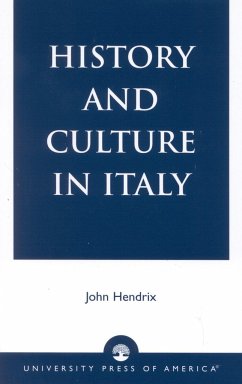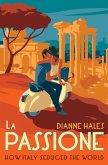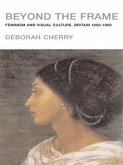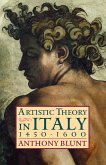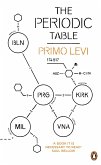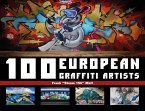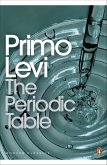John Shannon Hendrix
History and Culture in Italy
John Shannon Hendrix
History and Culture in Italy
- Broschiertes Buch
- Merkliste
- Auf die Merkliste
- Bewerten Bewerten
- Teilen
- Produkt teilen
- Produkterinnerung
- Produkterinnerung
History and Culture in Italy is a scholarly, introductory survey of the history and culture of Italy, focusing on art and architecture, literature and philosophy, politics and historical events, and observations of daily life in modern Italy.
Andere Kunden interessierten sich auch für
![La Passione: How Italy Seduced the World La Passione: How Italy Seduced the World]() Dianne HalesLa Passione: How Italy Seduced the World29,99 €
Dianne HalesLa Passione: How Italy Seduced the World29,99 €![Beyond the Frame Beyond the Frame]() Deborah CherryBeyond the Frame58,99 €
Deborah CherryBeyond the Frame58,99 €![Artistic Theory in Italy Artistic Theory in Italy]() Anthony BluntArtistic Theory in Italy38,99 €
Anthony BluntArtistic Theory in Italy38,99 €![The Periodic Table The Periodic Table]() Primo LeviThe Periodic Table16,99 €
Primo LeviThe Periodic Table16,99 €![100 European Graffiti Artists 100 European Graffiti Artists]() Frank "Steam 156" Malt100 European Graffiti Artists56,99 €
Frank "Steam 156" Malt100 European Graffiti Artists56,99 €![Frederic Bazille and the Birth of Impressionism Frederic Bazille and the Birth of Impressionism]() Michel HilaireFrederic Bazille and the Birth of Impressionism43,99 €
Michel HilaireFrederic Bazille and the Birth of Impressionism43,99 €![The Periodic Table The Periodic Table]() Primo LeviThe Periodic Table16,99 €
Primo LeviThe Periodic Table16,99 €-
-
-
History and Culture in Italy is a scholarly, introductory survey of the history and culture of Italy, focusing on art and architecture, literature and philosophy, politics and historical events, and observations of daily life in modern Italy.
Hinweis: Dieser Artikel kann nur an eine deutsche Lieferadresse ausgeliefert werden.
Hinweis: Dieser Artikel kann nur an eine deutsche Lieferadresse ausgeliefert werden.
Produktdetails
- Produktdetails
- Verlag: University Press of America
- Seitenzahl: 276
- Erscheinungstermin: 11. August 2003
- Englisch
- Abmessung: 221mm x 158mm x 21mm
- Gewicht: 368g
- ISBN-13: 9780761826286
- ISBN-10: 0761826289
- Artikelnr.: 21930469
- Herstellerkennzeichnung
- Libri GmbH
- Europaallee 1
- 36244 Bad Hersfeld
- gpsr@libri.de
- Verlag: University Press of America
- Seitenzahl: 276
- Erscheinungstermin: 11. August 2003
- Englisch
- Abmessung: 221mm x 158mm x 21mm
- Gewicht: 368g
- ISBN-13: 9780761826286
- ISBN-10: 0761826289
- Artikelnr.: 21930469
- Herstellerkennzeichnung
- Libri GmbH
- Europaallee 1
- 36244 Bad Hersfeld
- gpsr@libri.de
John Hendrix is Visiting Assistant Professor of Art and Architectural History, Roger Williams University, Rhode Island.
Chapter 1 Giordano Bruno and Intellectual Rebellion Chapter 2 Venice,
Vicenza and Milan Chapter 3 Paolo Portoghesi: Borromini and Postmodernism
Chapter 4 Mythological Origins in Crete and the Peloponnese Chapter 5
Giuseppe Mazzini and the Risorgimento Chapter 6 Baroque Architecture in
Turin Chapter 7 Primo Levi and Post-Holocaust Identity Chapter 8 Antonio
Gramsci and Marxist Cultural Theory Chapter 9 Vienna and the Origins of
Modernism Chapter 10 Prague: Creativity and the Subconscious Chapter 11
Giovanni Macchia: Sensuality and Modern Life Chapter 12 Futurism and the
Obsession with Speed Chapter 13 Calcio and Astrology and Modern Italy
Chapter 14 Silvio Berlusconi and Capitalist Politics Chapter 15 Life as
Spectacle Chapter 16 Calcata: A Bohemian Alternative Chapter 17 Franco
Archibugi and the Italian Language Chapter 18 Campo Marzio: The Heart of
Rome Chapter 19 Genoa and the French Riviera Chapter 20 Capri and Anacapri
Chapter 21 Thomas Aquinas and the Great Synthesis Chapter 22 Lorenzo Valla:
Philology and Textual Criticism Chapter 23 Tommaso Camanella: Political
Revolt and Utopia Chapter 24 Giambattista Vico and the Social Sciences
Chapter 25 Benedetto Croce and the Philosophy of the Spirit Chapter 26
Archetypes for Mythology and Christianity in Egypt Chapter 27 Olympia: The
Greek Arcadia Chapter 28 The Art Scene in Rome Chapter 29 The Villa
Farnesina Chapter 30 Seneca and Stoicism Chapter 31 Constantine and
Christianity Chapter 32 Cicero and the Art of Oration Chapter 33 Piazza San
Pietro and the Arms of the Church Chapter 34 Classical Philosophy in the
Vatican Chapter 35 Borromini: Humanism and Neoplatonism Chapter 36 The
Cornaro Chapel: Spiritual and Physical Ecstasy Chapter 37 Pompeii and the
Villa of the Mysteries Chapter 38 Plotinus: Plato and the Ennead Chapter 39
Saint Francis of Assisi and the Universal Spirit Chapter 40 Siena: The
Renaissance that Might Have Been Chapter 41 Saint Augustine and the
Christian Community Chapter 42 Leon Battista Alberti and the Modern
Architect Chapter 43 The City of Florence Chapter 44 Michelangelo:
Expression and Rebellion Chapter 45 The Platonic Academy Chapter 46 Sandro
Botticelli and Classical Mythology Chapter 47 Pisa: Monuments to an Empire
Chapter 48 Galileo and the Birth of Science Chapter 49 Umberto Eco and the
Importance of Semiotics Chapter 50 Andrea Palladio and Humanist
Architecture Chapter 51 Byzantine Mosaics in Ravenna Chapter 52 Giuseppe
Terragni: Architecture and Politics Chapter 53 Athens and Aix-en-Provence
Vicenza and Milan Chapter 3 Paolo Portoghesi: Borromini and Postmodernism
Chapter 4 Mythological Origins in Crete and the Peloponnese Chapter 5
Giuseppe Mazzini and the Risorgimento Chapter 6 Baroque Architecture in
Turin Chapter 7 Primo Levi and Post-Holocaust Identity Chapter 8 Antonio
Gramsci and Marxist Cultural Theory Chapter 9 Vienna and the Origins of
Modernism Chapter 10 Prague: Creativity and the Subconscious Chapter 11
Giovanni Macchia: Sensuality and Modern Life Chapter 12 Futurism and the
Obsession with Speed Chapter 13 Calcio and Astrology and Modern Italy
Chapter 14 Silvio Berlusconi and Capitalist Politics Chapter 15 Life as
Spectacle Chapter 16 Calcata: A Bohemian Alternative Chapter 17 Franco
Archibugi and the Italian Language Chapter 18 Campo Marzio: The Heart of
Rome Chapter 19 Genoa and the French Riviera Chapter 20 Capri and Anacapri
Chapter 21 Thomas Aquinas and the Great Synthesis Chapter 22 Lorenzo Valla:
Philology and Textual Criticism Chapter 23 Tommaso Camanella: Political
Revolt and Utopia Chapter 24 Giambattista Vico and the Social Sciences
Chapter 25 Benedetto Croce and the Philosophy of the Spirit Chapter 26
Archetypes for Mythology and Christianity in Egypt Chapter 27 Olympia: The
Greek Arcadia Chapter 28 The Art Scene in Rome Chapter 29 The Villa
Farnesina Chapter 30 Seneca and Stoicism Chapter 31 Constantine and
Christianity Chapter 32 Cicero and the Art of Oration Chapter 33 Piazza San
Pietro and the Arms of the Church Chapter 34 Classical Philosophy in the
Vatican Chapter 35 Borromini: Humanism and Neoplatonism Chapter 36 The
Cornaro Chapel: Spiritual and Physical Ecstasy Chapter 37 Pompeii and the
Villa of the Mysteries Chapter 38 Plotinus: Plato and the Ennead Chapter 39
Saint Francis of Assisi and the Universal Spirit Chapter 40 Siena: The
Renaissance that Might Have Been Chapter 41 Saint Augustine and the
Christian Community Chapter 42 Leon Battista Alberti and the Modern
Architect Chapter 43 The City of Florence Chapter 44 Michelangelo:
Expression and Rebellion Chapter 45 The Platonic Academy Chapter 46 Sandro
Botticelli and Classical Mythology Chapter 47 Pisa: Monuments to an Empire
Chapter 48 Galileo and the Birth of Science Chapter 49 Umberto Eco and the
Importance of Semiotics Chapter 50 Andrea Palladio and Humanist
Architecture Chapter 51 Byzantine Mosaics in Ravenna Chapter 52 Giuseppe
Terragni: Architecture and Politics Chapter 53 Athens and Aix-en-Provence
Chapter 1 Giordano Bruno and Intellectual Rebellion Chapter 2 Venice,
Vicenza and Milan Chapter 3 Paolo Portoghesi: Borromini and Postmodernism
Chapter 4 Mythological Origins in Crete and the Peloponnese Chapter 5
Giuseppe Mazzini and the Risorgimento Chapter 6 Baroque Architecture in
Turin Chapter 7 Primo Levi and Post-Holocaust Identity Chapter 8 Antonio
Gramsci and Marxist Cultural Theory Chapter 9 Vienna and the Origins of
Modernism Chapter 10 Prague: Creativity and the Subconscious Chapter 11
Giovanni Macchia: Sensuality and Modern Life Chapter 12 Futurism and the
Obsession with Speed Chapter 13 Calcio and Astrology and Modern Italy
Chapter 14 Silvio Berlusconi and Capitalist Politics Chapter 15 Life as
Spectacle Chapter 16 Calcata: A Bohemian Alternative Chapter 17 Franco
Archibugi and the Italian Language Chapter 18 Campo Marzio: The Heart of
Rome Chapter 19 Genoa and the French Riviera Chapter 20 Capri and Anacapri
Chapter 21 Thomas Aquinas and the Great Synthesis Chapter 22 Lorenzo Valla:
Philology and Textual Criticism Chapter 23 Tommaso Camanella: Political
Revolt and Utopia Chapter 24 Giambattista Vico and the Social Sciences
Chapter 25 Benedetto Croce and the Philosophy of the Spirit Chapter 26
Archetypes for Mythology and Christianity in Egypt Chapter 27 Olympia: The
Greek Arcadia Chapter 28 The Art Scene in Rome Chapter 29 The Villa
Farnesina Chapter 30 Seneca and Stoicism Chapter 31 Constantine and
Christianity Chapter 32 Cicero and the Art of Oration Chapter 33 Piazza San
Pietro and the Arms of the Church Chapter 34 Classical Philosophy in the
Vatican Chapter 35 Borromini: Humanism and Neoplatonism Chapter 36 The
Cornaro Chapel: Spiritual and Physical Ecstasy Chapter 37 Pompeii and the
Villa of the Mysteries Chapter 38 Plotinus: Plato and the Ennead Chapter 39
Saint Francis of Assisi and the Universal Spirit Chapter 40 Siena: The
Renaissance that Might Have Been Chapter 41 Saint Augustine and the
Christian Community Chapter 42 Leon Battista Alberti and the Modern
Architect Chapter 43 The City of Florence Chapter 44 Michelangelo:
Expression and Rebellion Chapter 45 The Platonic Academy Chapter 46 Sandro
Botticelli and Classical Mythology Chapter 47 Pisa: Monuments to an Empire
Chapter 48 Galileo and the Birth of Science Chapter 49 Umberto Eco and the
Importance of Semiotics Chapter 50 Andrea Palladio and Humanist
Architecture Chapter 51 Byzantine Mosaics in Ravenna Chapter 52 Giuseppe
Terragni: Architecture and Politics Chapter 53 Athens and Aix-en-Provence
Vicenza and Milan Chapter 3 Paolo Portoghesi: Borromini and Postmodernism
Chapter 4 Mythological Origins in Crete and the Peloponnese Chapter 5
Giuseppe Mazzini and the Risorgimento Chapter 6 Baroque Architecture in
Turin Chapter 7 Primo Levi and Post-Holocaust Identity Chapter 8 Antonio
Gramsci and Marxist Cultural Theory Chapter 9 Vienna and the Origins of
Modernism Chapter 10 Prague: Creativity and the Subconscious Chapter 11
Giovanni Macchia: Sensuality and Modern Life Chapter 12 Futurism and the
Obsession with Speed Chapter 13 Calcio and Astrology and Modern Italy
Chapter 14 Silvio Berlusconi and Capitalist Politics Chapter 15 Life as
Spectacle Chapter 16 Calcata: A Bohemian Alternative Chapter 17 Franco
Archibugi and the Italian Language Chapter 18 Campo Marzio: The Heart of
Rome Chapter 19 Genoa and the French Riviera Chapter 20 Capri and Anacapri
Chapter 21 Thomas Aquinas and the Great Synthesis Chapter 22 Lorenzo Valla:
Philology and Textual Criticism Chapter 23 Tommaso Camanella: Political
Revolt and Utopia Chapter 24 Giambattista Vico and the Social Sciences
Chapter 25 Benedetto Croce and the Philosophy of the Spirit Chapter 26
Archetypes for Mythology and Christianity in Egypt Chapter 27 Olympia: The
Greek Arcadia Chapter 28 The Art Scene in Rome Chapter 29 The Villa
Farnesina Chapter 30 Seneca and Stoicism Chapter 31 Constantine and
Christianity Chapter 32 Cicero and the Art of Oration Chapter 33 Piazza San
Pietro and the Arms of the Church Chapter 34 Classical Philosophy in the
Vatican Chapter 35 Borromini: Humanism and Neoplatonism Chapter 36 The
Cornaro Chapel: Spiritual and Physical Ecstasy Chapter 37 Pompeii and the
Villa of the Mysteries Chapter 38 Plotinus: Plato and the Ennead Chapter 39
Saint Francis of Assisi and the Universal Spirit Chapter 40 Siena: The
Renaissance that Might Have Been Chapter 41 Saint Augustine and the
Christian Community Chapter 42 Leon Battista Alberti and the Modern
Architect Chapter 43 The City of Florence Chapter 44 Michelangelo:
Expression and Rebellion Chapter 45 The Platonic Academy Chapter 46 Sandro
Botticelli and Classical Mythology Chapter 47 Pisa: Monuments to an Empire
Chapter 48 Galileo and the Birth of Science Chapter 49 Umberto Eco and the
Importance of Semiotics Chapter 50 Andrea Palladio and Humanist
Architecture Chapter 51 Byzantine Mosaics in Ravenna Chapter 52 Giuseppe
Terragni: Architecture and Politics Chapter 53 Athens and Aix-en-Provence

